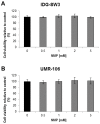The Bromodomain Inhibitor N-Methyl pyrrolidone Prevents Osteoporosis and BMP-Triggered Sclerostin Expression in Osteocytes
- PMID: 30366476
- PMCID: PMC6275050
- DOI: 10.3390/ijms19113332
The Bromodomain Inhibitor N-Methyl pyrrolidone Prevents Osteoporosis and BMP-Triggered Sclerostin Expression in Osteocytes
Abstract
(1) Background: In an adult skeleton, bone is constantly renewed in a cycle of bone resorption, followed by bone formation. This coupling process, called bone remodeling, adjusts the quality and quantity of bone to the local needs. It is generally accepted that osteoporosis develops when bone resorption surpasses bone formation. Osteoclasts and osteoblasts, bone resorbing and bone forming cells respectively, are the major target in osteoporosis treatment. Inside bone and forming a complex network, the third and most abundant cells, the osteocytes, have long remained a mystery. Osteocytes are responsible for mechano-sensation and -transduction. Increased expression of the osteocyte-derived bone inhibitor sclerostin has been linked to estrogen deficiency-induced osteoporosis and is therefore a promising target for osteoporosis management. (2) Methods: Recently we showed in vitro and in vivo that NMP (N-Methyl-2-pyrrolidone) is a bioactive drug enhancing the BMP-2 (Bone Morphogenetic Protein 2) induced effect on bone formation while blocking bone resorption. Here we tested the effect of NMP on the expression of osteocyte-derived sclerostin. (3) Results: We found that NMP significantly decreased sclerostin mRNA and protein levels. In an animal model of osteoporosis, NMP prevented the estrogen deficiency-induced increased expression of sclerostin. (4) Conclusions: These results support the potential of NMP as a novel therapeutic compound for osteoporosis management, since it preserves bone by a direct interference with osteoblasts and osteoclasts and an indirect one via a decrease in sclerostin expression by osteocytes.
Keywords: N-methyl pyrrolidone; bromodomain; osteocyte; osteoporosis; sclerostin.
Conflict of interest statement
The authors declare no conflict of interest.
Figures





Similar articles
-
The epigenetically active small chemical N-methyl pyrrolidone (NMP) prevents estrogen depletion induced osteoporosis.Bone. 2015 Sep;78:114-21. doi: 10.1016/j.bone.2015.05.004. Epub 2015 May 7. Bone. 2015. PMID: 25959414
-
Exendin-4 increases bone mineral density in type 2 diabetic OLETF rats potentially through the down-regulation of SOST/sclerostin in osteocytes.Life Sci. 2013 Mar 21;92(10):533-40. doi: 10.1016/j.lfs.2013.01.001. Epub 2013 Jan 25. Life Sci. 2013. PMID: 23357248
-
Sclerostin regulates release of bone mineral by osteocytes by induction of carbonic anhydrase 2.J Bone Miner Res. 2013 Dec;28(12):2436-48. doi: 10.1002/jbmr.2003. J Bone Miner Res. 2013. PMID: 23737439
-
Sclerostin, an osteocytes-derived bone-forming inhibitor.Pol Orthop Traumatol. 2013 Jul 1;78:151-4. Pol Orthop Traumatol. 2013. PMID: 23820854 Review.
-
Sclerostin expression and functions beyond the osteocyte.Bone. 2017 Mar;96:45-50. doi: 10.1016/j.bone.2016.11.024. Epub 2016 Nov 23. Bone. 2017. PMID: 27888056 Free PMC article. Review.
Cited by
-
Potential Functions of the BMP Family in Bone, Obesity, and Glucose Metabolism.J Diabetes Res. 2021 Jun 23;2021:6707464. doi: 10.1155/2021/6707464. eCollection 2021. J Diabetes Res. 2021. PMID: 34258293 Free PMC article. Review.
-
The regulatory roles of miR-26a in the development of fracture and osteoblasts.Ann Transl Med. 2022 Jan;10(2):37. doi: 10.21037/atm-21-6101. Ann Transl Med. 2022. PMID: 35282137 Free PMC article.
-
CGK733 alleviates ovariectomy-induced bone loss through blocking RANKL-mediated Ca2+ oscillations and NF-κB/MAPK signaling pathways.iScience. 2023 Aug 29;26(10):107760. doi: 10.1016/j.isci.2023.107760. eCollection 2023 Oct 20. iScience. 2023. PMID: 37720109 Free PMC article.
-
Insights into the bone morphogenetic protein signaling in musculoskeletal disorders: Mechanisms and crosstalk.J Orthop Translat. 2025 May 16;52:419-440. doi: 10.1016/j.jot.2025.03.005. eCollection 2025 May. J Orthop Translat. 2025. PMID: 40485850 Free PMC article. Review.
-
Linagliptin in Combination With Metformin Ameliorates Diabetic Osteoporosis Through Modulating BMP-2 and Sclerostin in the High-Fat Diet Fed C57BL/6 Mice.Front Endocrinol (Lausanne). 2022 Jul 19;13:944323. doi: 10.3389/fendo.2022.944323. eCollection 2022. Front Endocrinol (Lausanne). 2022. PMID: 35928902 Free PMC article.
References
-
- Foundation I.O. What Is Osteoporosis. [(accessed on 26 August 2018)]; Available online: https://www.iofbonehealth.org/epidemiology.
MeSH terms
Substances
Grants and funding
LinkOut - more resources
Full Text Sources
Medical

